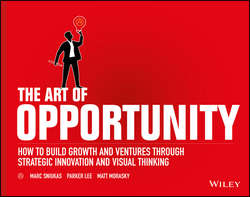Читать книгу The Art of Opportunity - Lee Parker - Страница 10
На сайте Литреса книга снята с продажи.
Part 1
Artful Innovation
Оглавлениеwe seize growth opportunities in a targeted way and benefit from the dynamic development of new business areas in the long term.
– PROSIEBENSAT.1 MEDIA Annual Report 2014 1
Chapter 1
When Thomas Ebeling became the new CEO of ProSiebenSat.1 Media AG (Pro7) in 2009, he faced a familiar problem: how to grow the business. Pro7 was the leading media company in the German TV advertising market with their core business of free TV – financed by advertising. Mr. Ebeling's challenge was how to grow the business and achieve over €1 billion in incremental revenues by 2018. Resorting to traditional strategic moves, expanding existing businesses and offerings, would certainly not do the trick.
Pro7 crafted a unique strategy for a new business area making TV advertising available to start-ups, and small and medium-sized companies, two customer segments that traditionally couldn't afford TV advertising and were seen as unprofitable by the industry. One year after the new business had been launched, it had already generated €20 million in profit. Five years later, Pro7 had achieved tremendous success with its new strategy. In fact, the strategy worked so well that in 2015, the €1 billion plus target was increased to €1.85 billion.
Business professionals and scholars admire achievements like these and wonder how Pro7 tapped into new markets and developed new business areas. Finding and seizing opportunities for new growth is, after all, the Holy Grail of business. And if Pro7 didn't use traditional growth methods, exactly how did they arrive at new offerings, complete with innovative business models and revenue models, to reach entirely new customer segments?
What Is Strategic Innovation?
The Art of Opportunity is about how strategic innovation and business design thinking can grow existing businesses and create completely new ones by discovering opportunities for new growth and crafting strategies to seize these opportunities.
Strategy is essentially about making choices about where to play and how to win. Strategic management theories offer frameworks to guide our thinking, help develop answers to these questions, and make such choices. The approach and concepts of The Art of Opportunity provide fresh and modern ways to look at these questions, enabling you to come up with more innovative answers than yesterday's traditional strategic management approaches might offer.
Traditional Strategic Management
On a Business Level, traditional strategic management 2 is primarily concerned with where to play and how to win. Where to play is framed as a choice of industry and product/market combination. Simply speaking, you pick an industry, say air transportation, and a market, for example continental flights in the United States, and you define your offering within this market, for example low-cost direct city-to-city flights.
How to win is mostly defined as achieving competitive advantage. Michael Porter's classic generic choices 3 about how to achieve competitive advantage are to either (1) be a cost leader, (2) differentiate your offering, or (3) focus on a niche. Treacy and Wiersema4 offer three choices to win: (1) product leadership (offer the best product by focusing on product innovation); (2) operational excellence (be a price and convenience leader by focusing on low cost, lean and fast production, and speedy delivery); or (3) customer intimacy (win by creating loyal customers through tailored offerings and focusing on customer relationships).
Конец ознакомительного фрагмента. Купить книгу
1
“Annual Report 2014.” ProSiebenSat.1. 2015. http://annual-report2014.prosiebensat1.com
2
To make our point, we are presenting the basics of strategy in a very simple way here. For a more elaborate explanation, we suggest reviewing Bob De Wit and Ron Meyer, Strategy: Process, Content, Context (Boston: Cengage Learning, 2010).
3
M. E. Porter, The Competitive Advantage: Creating and Sustaining Superior Performance (New York: Free Press, 1985) 2005.
4
Michael Treacy and Fred Wiersema, The Discipline of Market Leaders (Addison-Wesley, 1995).
